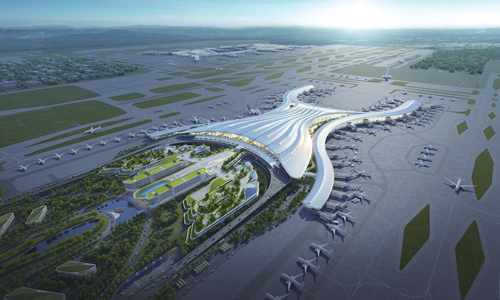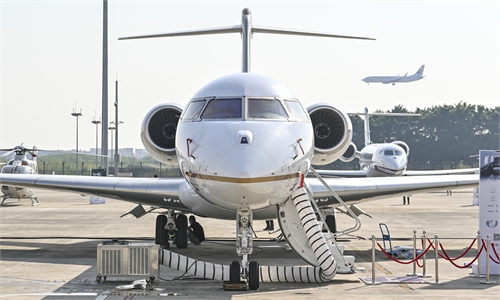Airports construction speeding up in the Greater Bay Area
New round competition for airspace, routes, and passengers expected

Rendering of Terminal 3 of Guangzhou Baiyun International Airport in Guangzhou, South China's Guangdong Province Photo: cnsphoto
The construction of airport facilities in the Guangdong-Hong Kong-Macao Greater Bay Area (GBA) has been accelerating spurred by the country's strategic focus on the region.
Hong Kong marked the completion of a third runway on Tuesday. The 3.9-kilometre runway is expected to enter operation during 2022.
With a complete three runway facility in place, Hong Kong's annual passenger volume will be increased to 120 million passengers with an annual cargo volume can reach 10 million tons.
Guangdong is also implementing plans to build a world-class cluster of coastal ports and airports by 2025. Guangdong's local transportation department said earlier that Guangdong will approve the expansion of the third stage of Baiyun airport and the construction of a third runway in Shenzhen, backed by the vision to provide the region with a modernized transportation system that connects China and the world.
The fast development of local airports is in accordance with government planning and urban development policy, with several high-profile policies regarding Guangdong-Hong Kong-Macao GBA rolled out over recent days.
According to a plan released by Civil Aviation Administration of China last year, China will build a world-class airport cluster in the Guangdong-Hong Kong-Macao GBA by 2025, including building Guangzhou and Shenzhen international aviation hubs, consolidate Hong Kong's status as an international aviation hub, improve Macao airport's service capacity, as well as upgrade nearby Zhuhai airport.
It is estimated that by 2035, Hong Kong airport will be home to three runways, with five in Guangzhou, three in Shenzhen, and one each in Zhuhai, Macao, compared with current nine existing runways currently within the GBA region in 2o20.
However, behind the deepening cooperation in the GBA, there is also an undercurrent of aviation competition and pressure in terms of airline cooperation, construction, airspace, and an increasingly complex route network.
Media reports reveal that air passenger throughput in the Pearl River Delta region excluding Hong Kong and Macao increased from 40.5 million passengers in 2005 to 142 million in 2019, an average annual increase of over 9 percent.
With Hong Kong and Macao included, the annual passenger throughput of transport airports in the GBA doubled from 110 million to 223 million from 2008 to 2019.
Currently, about 90 percent of all air traffic in the region is concentrated across the three airports in Guangzhou, Hong Kong and Shenzhen, meaning these airports are often faced with capacity overload during peak travel seasons.
Baiyun airport, for example, recorded an annual passenger throughput of 73.38 million in 2019, while the airport infrastructure, with a design capacity of 80 million passengers per year, is now close to capacity.
Being the most economically developed and densely populated region in China, major cities in the Pearl River Delta and the Yangtze River Delta host a high volume of air traffic, meaning airspace resources in the region are already very tight.
In the process of building a world-class city cluster in the future, the issues of limited airspace is likely to be further exacerbated as the economy and population grow, market watchers have claimed.
Competition for limited resources between Guangzhou and Shenzhen airports is expected to intensify, and the runways in Shenzhen and Hong Kong will also face the competition on routes and passengers, Qi Qi, the market watcher who closes follows the GBA aviation industry told the Global Times on Wednesday.
"Individual development is definitely not the proper path for the high-quality development of the world-class airport cluster in the GBA," Qi said.
On Monday, China announced an expansion of the Qianhai economic cooperation zone in Shenzhen, and the expansion is part of a plan to further integrate Hong Kong and Macao's economies into the GBA.
One day earlier, China launched a plan in Hengqin, an area located in the southern part of Zhuhai city in Guangdong Province, just adjacent to Macao, and the plan will facilitate Macao's better integration into the development of the GBA.
The development of the GBA has an important strategic position in China's overall development, and the construction is a new practice to promote the development of "one country, two systems" policy.
It remains to be seen whether the three international airports can truly form a world-class aviation hub cluster.
If the competition with each other can't be immediately addressed, coordination costs in the future will be more enormous, experts said.


